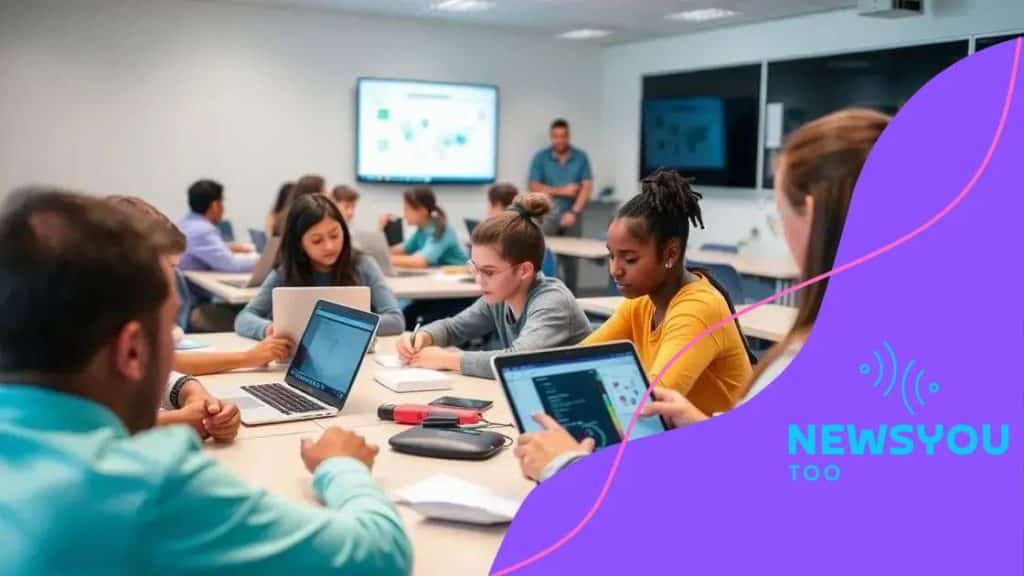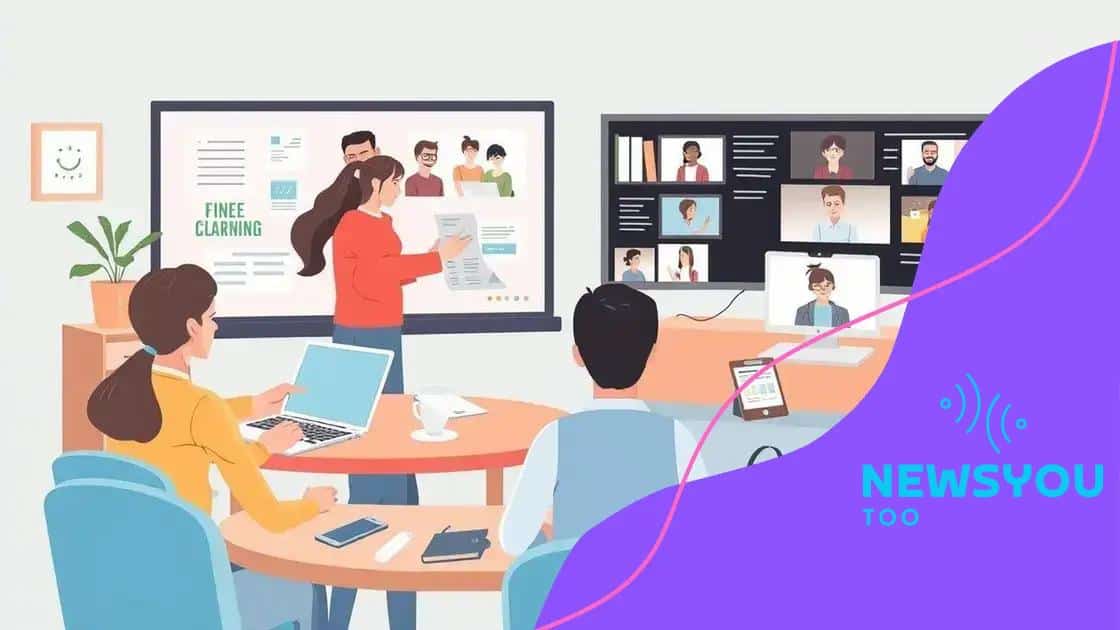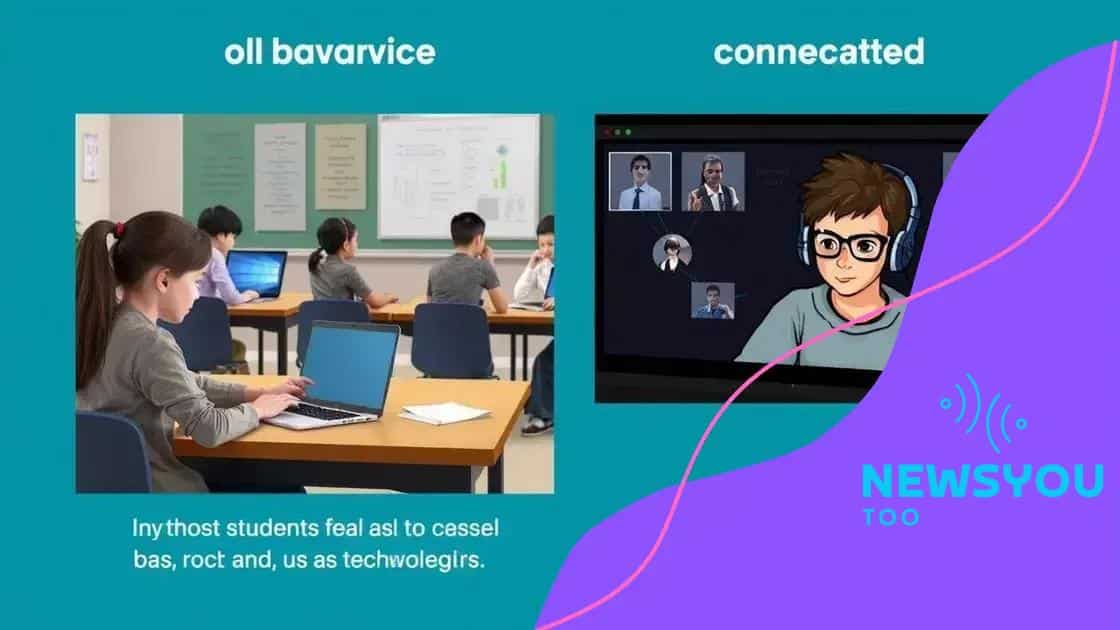The benefits of hybrid classrooms in higher education

Anúncios
Hybrid classrooms combine in-person and online learning, enhancing flexibility, engagement, and personalized education while leveraging technology to address diverse student needs.
The benefits of hybrid classrooms in higher education are changing how we approach learning. Imagine combining traditional teaching with modern technology—this dynamic approach might be just what students need to thrive!
Anúncios
Understanding hybrid classrooms
Understanding hybrid classrooms goes beyond just mixing in-person and online learning. It involves creating a flexible environment where students can thrive in various ways. By merging traditional classroom teachings with digital tools, these classrooms are reshaping education.
The core elements of hybrid classrooms
Hybrid classrooms utilize both face-to-face and online learning methods. This blend allows for a more personalized educational experience. Students can attend classes in person or participate remotely, which is especially beneficial for those who may have scheduling conflicts or health concerns.
Key features include:
- Interactive technology that fosters engagement
- Flexible scheduling options for students
- Tailored learning experiences that cater to different needs
In these environments, technology plays a crucial role. Tools like video conferencing, learning management systems, and interactive platforms help bridge the gap between students and educators. These features create a seamless learning experience, ensuring that everyone stays connected, no matter where they are.
Anúncios
Moreover, classroom participation is enhanced. Students can contribute to discussions in real time or engage in group work from their devices. This flexibility encourages collaboration among peers, strengthening their understanding of the material.
Benefits of a hybrid model
The benefits of hybrid classrooms are significant. They cater to diverse learning styles, allowing students to learn at their own pace. With resources available both online and in-person, students have the opportunity to access materials that best suit their learning preferences.
Additionally, this approach prepares students for the future workforce, where remote collaboration and digital tools are commonplace. Emphasizing critical thinking and problem-solving skills, hybrid environments cultivate a readiness for real-world challenges.
Key benefits for students and educators

The key benefits for students and educators in hybrid classrooms are profound and transformative. This approach allows for more customized learning experiences, making education more engaging for everyone involved.
Enhanced flexibility
One significant advantage is the added flexibility that hybrid classrooms provide. Students can choose how and when they learn, whether attending lectures in person or accessing materials online. This flexibility accommodates diverse schedules and learning preferences.
Benefits for students include:
- Increased control over their own learning pace
- Opportunities to revisit recorded lectures
- Greater access to diverse educational resources
Additionally, students gain valuable skills in independent learning and digital literacy. These skills are becoming essential in today’s technology-driven world.
Benefits for educators
Educators also experience numerous advantages from this hybrid approach. By leveraging technology, they can reach a broader range of students and cater to varying learning styles. They can easily incorporate multimedia resources into their lessons, making learning more interactive and effective.
Furthermore, teachers can utilize analytics tools to monitor student progress in real time. This data allows them to tailor their teaching strategies to address the unique needs of each student.
Moreover, the hybrid model fosters a collaborative environment where educators can share best practices and resources. Working together, they can enhance the educational experience for all students.
Technological tools to enhance hybrid learning
Incorporating technological tools in hybrid learning environments is crucial for maximizing student engagement and educational effectiveness. These tools facilitate seamless communication and access to resources, whether students are learning in person or online.
Essential tools for hybrid classrooms
One of the most important aspects of a successful hybrid classroom is the technology that supports it. Educators can enhance the learning experience with tools that allow for real-time interaction and collaboration.
Key technologies include:
- Video conferencing platforms, like Zoom or Microsoft Teams
- Learning management systems (LMS) such as Canvas or Google Classroom
- Interactive whiteboards to facilitate group discussions
- Online assessment tools that provide instant feedback
Video conferencing platforms allow students to attend lectures from anywhere, maintaining connection with their peers. Learning management systems serve as a central hub for resources, assignments, and communication. This centralized approach ensures that all students have equal access to the materials they need to succeed.
Interactive whiteboards enable educators to present engaging content while allowing students to contribute actively, whether they’re in the classroom or participating remotely. This interaction encourages participation from all students, regardless of their location.
Online assessments and feedback
Using online assessment tools also plays a vital role in hybrid learning. They enable educators to track student progress effectively and provide instant feedback. This immediate response helps students understand their strengths and weaknesses, guiding their learning paths.
Furthermore, technology can support personalized learning experiences. By analyzing data from assessments, teachers can tailor their instruction to meet individual student needs. This adaptability is essential for effective teaching in a hybrid model.
Challenges faced in hybrid environments

Hybrid learning environments bring numerous challenges that educators and students must navigate. While the benefits are clear, understanding the obstacles helps in creating effective solutions.
Technology Dependence
One notable challenge is the reliance on technology. Not every student may have access to reliable devices or high-speed internet. This digital divide can create unfair advantages and hinder participation for some learners.
Key issues include:
- Inconsistent access to necessary technology
- Difficulty in troubleshooting technical problems
- Variable comfort levels with online tools
Moreover, when technology fails, it disrupts learning for everyone involved. Educators must be prepared to handle these technical difficulties swiftly to minimize interruptions.
Engagement and Motivation
Another challenge is keeping students engaged. In a hybrid setup, some may feel isolated when learning online. This distance can lead to reduced motivation and a lack of participation. Building a sense of community is crucial for maintaining enthusiasm among all learners.
Teachers need to implement strategies to foster interaction, such as group projects that involve both in-person and online students. When students feel connected to their peers, they are more likely to participate actively.
Assessment Difficulties
Assessing student performance in hybrid environments also poses unique challenges. Traditional assessment methods may not translate well to online formats. Educators may struggle to evaluate students fairly and consistently across both learning modes.
To address this issue, schools can explore diverse assessment tools that work for both online and in-person formats. Embracing varied evaluation methods can provide a more comprehensive picture of student understanding.
Despite these challenges, recognizing them is the first step towards finding effective solutions. By addressing these issues collectively, educators can improve hybrid learning experiences for all students.
Future trends in hybrid education
The future trends in hybrid education show promise for enhancing learning experiences for both students and educators. As technology continues to evolve, the educational landscape adapts to meet the needs of learners better.
Increased Use of Artificial Intelligence
One significant trend is the integration of artificial intelligence (AI) tools in education. AI can help personalize learning by adapting content to suit individual student needs. These tools analyze student performance and offer tailored resources, making the learning process more efficient.
Potential AI applications include:
- Intelligent tutoring systems that provide support
- Automated grading systems for quick feedback
- AI chatbots that assist with student inquiries
As AI becomes more accessible, it can change how educators support students, allowing for more dynamic and responsive teaching methods.
Shift to Blended Learning Models
Another trend is the shift towards blended learning models. This approach combines traditional face-to-face instruction with online learning, giving students more flexibility in their education. Blended learning encourages students to take charge of their learning, promoting self-discipline and responsibility.
By blending the two worlds, educators can offer varied learning experiences that cater to diverse needs. This can lead to an increase in student engagement as well. Students can benefit from hands-on activities in the classroom while also having access to online resources and discussions.
Focus on Mental Health and Well-Being
Future trends also emphasize the importance of mental health and well-being in education. Recognizing the pressures students face, educators are becoming more aware of the need to support emotional health. Schools are implementing programs that promote mindfulness, resilience, and emotional intelligence.
Integrating these practices into a hybrid model ensures that students feel supported, whether in-person or online. Creating an inclusive environment helps students navigate their educational journeys more successfully.
FAQ – Frequently Asked Questions about Hybrid Classrooms
What are the main benefits of hybrid classrooms?
Hybrid classrooms provide flexibility, personalized learning experiences, and enhanced engagement by combining in-person and online learning.
What technology is essential for hybrid learning?
Key technologies include video conferencing tools, learning management systems, interactive whiteboards, and online assessment platforms.
How can teachers keep students engaged in a hybrid environment?
Teachers can promote interaction through group projects, real-time discussions, and utilizing diverse multimedia resources to maintain interest.
What are some challenges faced in hybrid education?
Challenges include ensuring access to technology, maintaining motivation among students, and accurately assessing student performance across formats.





